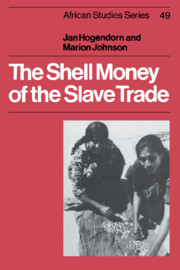Book contents
- Frontmatter
- Contents
- Maps
- Tables and chart
- Preface
- Introduction
- 1 The cowrie
- 2 The Maldive Islands
- 3 The Portuguese domination
- 4 The Dutch and English enter the trade (seventeenth century)
- 5 Prosperity for the cowrie commerce (eighteenth century)
- 6 Boom and slump for the cowrie trade (nineteenth century)
- 7 Collection, transport and distribution
- 8 Cowries in Africa
- 9 The cowrie as money: transport costs, values and inflation
- 10 The last of the cowrie
- Notes
- Bibliogaphy
- Index
4 - The Dutch and English enter the trade (seventeenth century)
Published online by Cambridge University Press: 12 October 2009
- Frontmatter
- Contents
- Maps
- Tables and chart
- Preface
- Introduction
- 1 The cowrie
- 2 The Maldive Islands
- 3 The Portuguese domination
- 4 The Dutch and English enter the trade (seventeenth century)
- 5 Prosperity for the cowrie commerce (eighteenth century)
- 6 Boom and slump for the cowrie trade (nineteenth century)
- 7 Collection, transport and distribution
- 8 Cowries in Africa
- 9 The cowrie as money: transport costs, values and inflation
- 10 The last of the cowrie
- Notes
- Bibliogaphy
- Index
Summary
The Dutch and English East India Companies, attracted by the fabulous profits of the spice trade, were in the field as competitors to the Portuguese shortly after the start of the seventeenth century. The Vereenigde Oost-Indische Compagnie, V.O.C. for short, was chartered in 1602 with the monopoly grant of Dutch trade east of the Cape of Good Hope and west of Cape Horn. From their eastern headquarters at Batavia, they rapidly expanded their many lines of commerce, and in particular they captured from the Portuguese much of the lucrative importation of pepper and other spices. The English East India Company (E.I.C.) was chartered even earlier, in 1600, but its first years were less successful than those of the V.O.C; one reason was the severe lack of working capital, only one-tenth of the Dutch company's in the early period. The E.I.C.'s headquarters at Fort St. George, Madras, was built in 1640. Its national monopoly extended over the same vast area as the Dutch grant. Together, the V.O.C. and E.I.C. captured from the Portuguese the cowrie commerce to Africa, and thenceforth were the main suppliers of what was to become the shell money of the slave trade.
THE DUTCH ENTER THE TRADE
The first Dutch vessel to visit the Maldives of which there is record came appropriately in the year the V.O.C. was chartered, 1602. The ship was from Middleburg, and after a stay of five days reported that “business could be done there.” But nothing came of it for nearly forty years, when, in 1640, a Dutch ship loaded with rice was sent from Ceylon to study trade possibilities. Cowrie purchases began shortly thereafter.
- Type
- Chapter
- Information
- The Shell Money of the Slave Trade , pp. 37 - 46Publisher: Cambridge University PressPrint publication year: 1986

